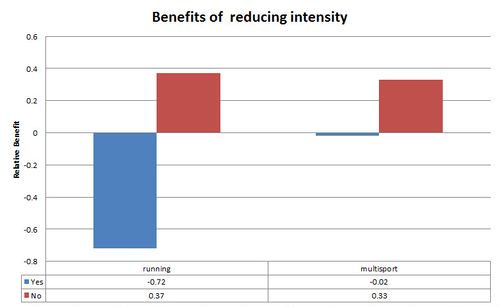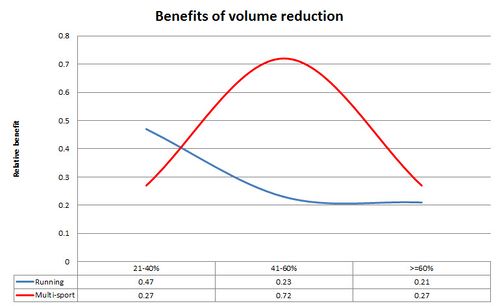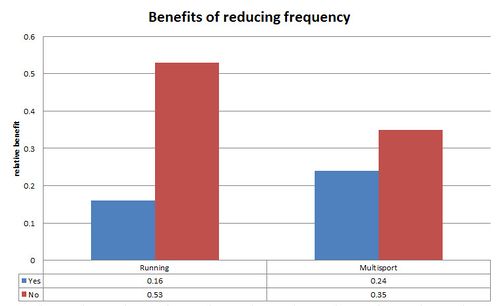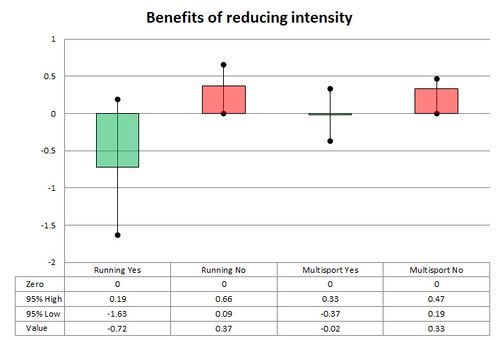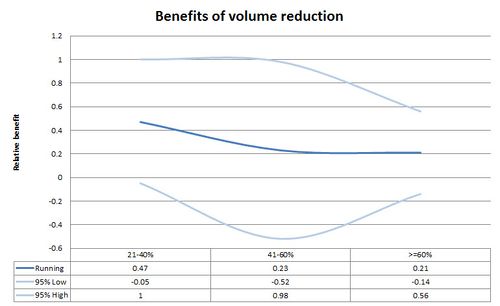The Science of Tapering
Tapering 101 looks in depth at tapering, following on from Practical Tapering
Contents
1 The Experiment of One
The studies [1] of tapering indicate a high level of individual variability. This variation is as wide as 8.9% improvement to 2.3% reduction in measured performance. This may be variation from individual to individual, but it seems to me that it may also depend on the specifics of the overall training plan. Consider two marathon runners; one is building up their weekly long run as 14, 16, 18, 20, while the other has been doing 20 miles runs for several months. It seems reasonable that the two runners would require different tapers. The runner who has been quickly building up their long run distance is likely to have more muscle damage as the body will have had little time to adjust to the distance. What does this mean to you? It means you may have to experiment with differing tapers, or at least consider different approaches.
2 Tapering for running or other sports
This section compares the results of tapering for running with the combined results of tapers for swimming, cycling and running. Note that these results are from many different studies, but the running studies are not looking at marathon or greater distance races, so caution is required in interpreting the results.
2.1 Training Intensity
As you can see reducing intensity has a much bigger negative impact on running than it does multisport tapers.
2.2 Mileage
The results of different volume (mileage) reductions are quite different for running. Where other sports seem to benefit most from 40-60% reduction, running benefits most from a smaller 20-40% reduction.
2.3 Taper Length
The results of a 1 or 2 week taper are similar for running and multisport, but the 3 and 4 week taper results are quite different.
2.4 Training Frequency
Again, there are noticeable differences between running and multisport tapers. The impact of reducing frequency of running is greater, so keeping the same frequency is more important.
3 Variability of Tapering Results
This section looks at how much variability there is in tapering results. These diagrams show the 95% confidence level. This means that one in twenty runners will be at one end of the 95% confidence level or the other.
3.1 Training Intensity
You can see quite a lot of variability in the running results, but tapers without reducing intensity do not have a negative impact on performance; at worse they are no different to not tapering.
3.2 Mileage
Here you can see that all mileage reductions can produce a negative result for some runners. The 40-60% range has the greatest potential for a negative result, so a smaller reduction seems best.
3.3 Taper Length
For taper length, the 95% levels follow the general trend, with two weeks being optimal and not producing a negative result even for the worst off 5%.
3.4 Training Frequency
Again, there are noticeable differences between running and multisport tapers. The impact of reducing frequency of running is greater, so keeping the same frequency is more important.
4 Tapering and Altitude Training for Sea Level Competition
When using Altitude Training such as Intermittent Hypoxic Exposure to improve sea level performance, the general advice is to terminate training a 4-7 days before competition. However, this is based on anecdotal evidence rather than scientific study.
5 Tapering and High Altitude Competition
Altitude acclimatization generally takes 1-2 weeks, with 4 weeks as the recommended minimum to achieve benefits. It is commonly advised that if you can't arrive in time to acclimate to the altitude, it's best to arrive at altitude as close to the time of competition as possible. This is based on the mistaken belief that there is a period of negative impact from a short period at altitude, but the evidence contradicts this and it's best to arrive as early as possible, even if that's only a day or two before the competition. However, competing at altitude without doing some type of Altitude Training is foolish, as Intermittent Hypoxic Exposure systems such as AltoLab are cheap and easy to use.
6 See also
7 References
- ↑ Effects of Tapering on Performance: A Meta-Analysis : Medicine & Science in Sports & Exercise [http://journals.lww.com/acsm-msse/pages/articleviewer.aspx?year=2007&issue=08000&article=00019&type=abstract</ref http://journals.lww.com/acsm-msse/pages/articleviewer.aspx?year=2007&issue=08000&article=00019&type=abstract
